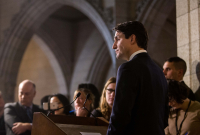Support strong Canadian climate journalism for 2025
The number of newborns taken into care dropped dramatically as birth alerts ended across Canada, but child welfare experts warn ceasing the practice cannot be the only step governments take to keep families together.
“(Birth alerts) really risk being kind of a red herring in the real issue of ensuring that children have an adequate opportunity to grow up with their families,” said Cindy Blackstock, executive director of the First Nations Child and Family Caring Society.
“What we really need to get at is issues of systemic racism, poverty and domestic violence.”
Birth alerts were used to notify hospitals and child-welfare agencies that a more thorough assessment was needed before a newborn was discharged to a parent deemed high-risk.
The practice had long been criticized by Indigenous leaders and other people of colour. The final report of the National Inquiry into Missing and Murdered Indigenous Women and Girls said they were “racist and discriminatory, and are a gross violation of the rights of the child, the mother and the community.”
Some areas stopped using birth alerts a long time ago, but provinces only ended the practice in recent years. Yukon, British Columbia and Alberta stopped in 2019. Manitoba and Ontario ended the practice the following year.
Saskatchewan stopped using birth alerts early in 2021, with New Brunswick, Newfoundland and Labrador and Nova Scotia following later that year.
Data obtained by The Canadian Press through freedom-of-information requests shows that 496 newborns nationally were taken into care in 2021 in regions that had ended birth alerts. It marked a drop of 52 per cent from 2018 when 1,034 were apprehended in those regions.
However, apprehensions of babies 12 months and younger dropped only 36 per cent from 2,957 in 2018 to 1,881 in 2021. Much of that decrease is from the effect of the decline in newborn apprehensions.
The Canadian Press analysis looked at the regions that ended birth alerts in 2019 and 2020: British Columbia, Alberta, Manitoba, Yukon and Ontario. It also looked at Saskatchewan, which ended the practice early in February 2021.
Regions that ended birth alerts later in 2021 were not included in the analysis because experts say it would be too early to know the effect.
Jeannine Carriere, a Métis social work professor at the University of Victoria, said ending birth alerts was a good decision, but she worries governments are using the move as a "deflection away from the structural and ongoing colonial policies around major issues."
She added: “Poverty is the No. 1 factor for Indigenous kids coming into contact with the child welfare system."
Indigenous children make up more than one half of all foster children 14 and younger, but only 7.7 per cent of kids that age in the Canadian population, 2016 census data indicates. Thirty-eight per cent of Indigenous children in Canada live in poverty, compared to seven per cent for non-Indigenous kids.
Experts say the overrepresentation is linked to centuries of policies of assimilation and discrimination, such as residential schools.
Carriere said pregnant people need culturally relevant and accessible prenatal care, as well as stable housing and other health and addictions care before a child is born. They also need support after the birth with schooling, employment and connections with community.
“Colonialism isn’t something of the past. It’s something that is ongoing," Carriere said.
British Columbia saw a 51.4 per cent decrease in newborns taken into care since birth alerts ended.
Manitoba had a 65 per cent decrease in newborns apprehended after the practice stopped. But the downturn was much less dramatic for babies 12 months and younger — 32 per cent from the year before and after birth alerts stopped.
There are about 10,000 children in care in Manitoba and about 90 per cent are Indigenous.
It’s one thing to say birth alerts will end, but another to significantly reduce the number of children in care, said the First Nations family advocate for the Assembly of Manitoba Chiefs.
Cora Morgan said her first time witnessing a birth alert was shocking.
"How can you do something so cruel?"
Her office continues to get calls from pregnant people worried their babies will be taken. Prevention is needed at the community level, Morgan said.
Governments have money to put children in foster placements, she said, but not to support families staying together.
Ending birth alerts has had no effect on the underlying circumstances that put families at risk, added Bryn King, a social work professor at the University of Toronto.
Ontario saw a 45 per cent decrease in newborn apprehensions in the year before and after birth alerts ended. There was a 25 per cent per cent decrease for babies aged four days to 12 months.
King said there needs to be a conversation about the appropriate scope for child welfare intervention. If a child has been harmed or there’s an immediate risk, then social workers should act, King said.
But, too often, "we are apprehending because there are circumstances that are potentially risky and we haven’t done anything to address those circumstances," she said.
Every effort must be taken to ensure caregivers have opportunities to address possible risks, King said. That means looking at other interventions, such as housing and mental health support.
Ending birth alerts alone is not the solution, she said.
“We spend a lot of money on investigations but not enough on the services and support that would preclude the need for an investigation.”
This report by The Canadian Press was first published Sept. 19, 2022.




Comments